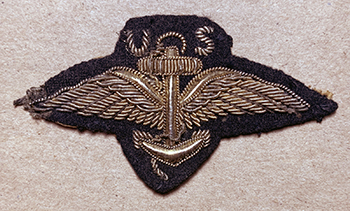
|
|
Width:
Height:
Hallmark:
Pin/Clutch:
Contributor:
Date Added:
Note:
|
2 3/4"
1 9/16"
Cliff Presley Collection
12/06/2021
Made in England, this badge was worn by Ensign Robert L. Piper, Jr. - Naval Aviator #667 LTA. This exceedingly rare badge was only ever received by 15 U. S. Naval Aviators. Those 15 men were the first group of US Navy Seamen sent to England in 1917 after the US declared war against Germany. Their mission? To learn how to fly dirigibles/airships with the RNAS and then do submarine patrol duty flying over the North Sea and the English Channel. It is an absolute treat to be able to display this badge on the site. You can also see Ensign Piper's transitional RAF badge in the WW1 Britain section.
|
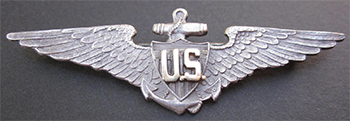
|
|
Width:
Height:
Hallmark:
Pin/Clutch:
Contributor:
Date Added:
Note:
|
2 3/4"
Sterling
Pin Back
Cliff Presley Collection
12/28/2020
This is the 1917 "Type 1" badge with gold 'U.S.' letters on the center shield. Designed in September 1917 by Lt. Henry Reuterdahl USNRF who assisted Lt. Commander John H. Towers (Naval Aviator No. 3) in collaboration with Bailey, Banks and Biddle on the design of an official Naval Aviator pilot badge. On 5 October 1917 Lt. Reuterdahl had BB&B add a slight curve to the shape of the body and feathers along with a redesigned rope and left fluke becket. On 12 October 1917 the letters 'U.S.' were officially omitted. That same month the Navy Bureau of Navigation (BuNav) also rejected the silver wings in favor of bronze.
|
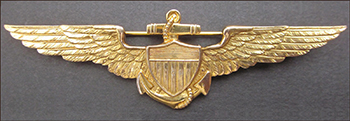
|
|
Width:
Height:
Hallmark:
Pin/Clutch:
Contributor:
Date Added:
Note:
|
Pin
Cliff Presley Collection
2/10/2021
The die for this 3 1/4" wide badge with closed flukes was made by Bailey, Banks & Biddle in 1917 while the firm was competing for a contract with the U. S. Navy. Eventually, the Navy contract was awarded to Bailey, Banks & Biddle in November 1917 but for another badge 2 3/4" wide with closed flukes; however, the firm continued making examples of this badge for sale in both 14k-gold and Sterling Silver with a gold wash.
|
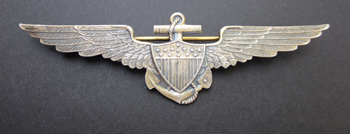
|
|
Width:
Height:
Hallmark:
Pin/Clutch:
Contributor:
Date Added:
|
RS
Pin Back
Cliff Presley Collection
9/13/2010
|
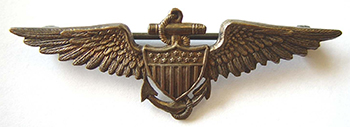
|
|
Width:
Height:
Hallmark:
Pin/Clutch:
Contributor:
Date Added:
|
2 11/16"
7/8"
Dunham Made, S.A. Tex., Sterling
Pin Back
Jack Bethune Collection
12/02/2021
|
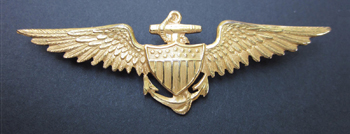
|
|
Width:
Height:
Hallmark:
Pin/Clutch:
Contributor:
Date Added:
Note:
|
1/20 10k GF
Pin Back
Cliff Presley Collection
9/13/2010
This badge was made by Dan S. Dunham
|
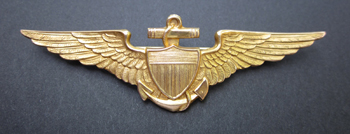
|
|
Width:
Height:
Hallmark:
Pin/Clutch:
Contributor:
Date Added:
Note:
|
10k
Pin Back
Cliff Presley Collection
9/13/2010
This badge was worn by Albert W. Dorgan, Naval Aviator #1642
|
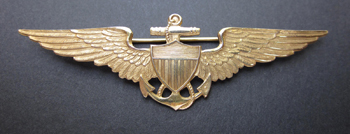
|
|
Width:
Height:
Hallmark:
Pin/Clutch:
Contributor:
Date Added:
|
14k
Pin Back
Cliff Presley Collection
9/13/2010
|
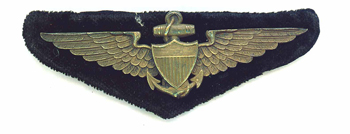
|
|
Width:
Height:
Hallmark:
Pin/Clutch:
Contributor:
Date Added:
Note:
|
2 3/4"
MG inside elongated diamond
Pin back
Richard King Collection
8/23/2010
This is a WW1 era style wing
|

|
|
Width:
Height:
Hallmark:
Pin/Clutch:
Contributor:
Date Added:
Note:
|
2 3/4"
BB&B, Bronze
Pin Back
Rich Witt
9/09/2002
This is a WWI to early post war period piece.
|
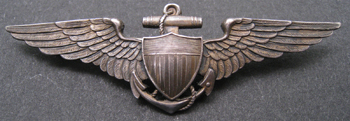
|
|
Width:
Height:
Hallmark:
Pin/Clutch:
Contributor:
Date Added:
Note:
|
2 3/4"
Early Robbins Hallmark, Sterling
Pin Back
10/06/2010
This wing belonged to John MacKay Lott, Naval Aviator 1187. He received his Naval Aviator designation on the 7th of July, 1918.
|
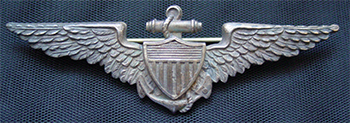
|
|
Width:
Height:
Hallmark:
Pin/Clutch:
Contributor:
Date Added:
|
Sterling, William Link, Co hallmark
Pin Back
John Ferguson Collection
8/27/2022
|
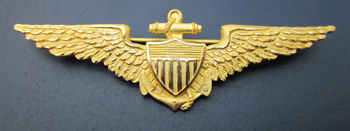
|
|
Width:
Height:
Hallmark:
Pin/Clutch:
Contributor:
Date Added:
Note:
|
2 3/4"
Pin Back
Cliff Presley Collection
4/11/2011
This wing was made by the Wm. Link Co.
|
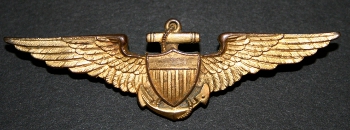
|
|
Width:
Height:
Hallmark:
Pin/Clutch:
Contributor:
Date Added:
Note:
|
B,B & B, Bronze
Pin
Dennis Jackson Collection
5/3/2011
Worn by Ensign George Ludlow - Navy Cross - Silver & Bronze Italian Medal of Valor - Involved in the Navy Aviation's only Medal of Honor Action Adriatic Sea near Polo - Austrian Air Base
|
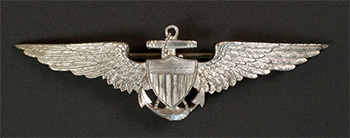
|
|
Width:
Height:
Hallmark:
Pin/Clutch:
Contributor:
Date Added:
Note:
|
Pin
Tod Rathbone Collection
2/5/2021
Silver Tiffany style wing although not marked by them. The use of this wing is unknown at this point.
|

|
|
Width:
Height:
Hallmark:
Pin/Clutch:
Contributor:
Date Added:
Note:
|
Pin
Tod Rathbone Collection
2/5/2021
Blackinton WWI pattern un-hallmarked
|
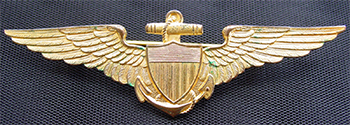
|
|
Width:
Height:
Hallmark:
Pin/Clutch:
Contributor:
Date Added:
|
Pin
John Ferguson Collection
2/24/2021
|
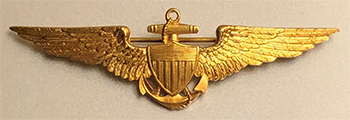
|
|
Width:
Height:
Hallmark:
Pin/Clutch:
Contributor:
Date Added:
Note:
|
2 3/4"
TIFFANY & Co MAKERS
Pin/90 deg/Blanchard (Tiffany) catch
CWNORMA Collection
8/28/2021
This 18K badge belonged to Lieutenant JG Lincoln Sumner Wilson NA#1171.
|
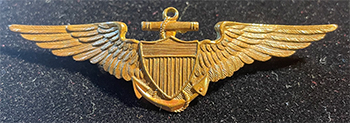
|
|
Width:
Height:
Hallmark:
Pin/Clutch:
Contributor:
Date Added:
Note:
|
2 3/4"
100 degree/unusual lever-type
CWNORMA Collection
8/28/2021
This die-struck gilt bronze badge belonged to 2nd Lieut Edward Rae Young, USMC. Young earned his wings in October 1918. Too late to serve in France. He was mustered out of active service in December 1918. He continued flying in reserve status for a few more years. Young was recalled to service in WW2.
|

|
|
Width:
Height:
Hallmark:
Pin/Clutch:
Contributor:
Date Added:
Note:
|
Fattorini & Sons, Bradford
Pin
Tod Rathbone Collection
05/25/2022
A full-size naval aviator wing made during WWI in the UK. Manufactured in bronze by the firm Fattorini & Sons, Bradford, which was a long and prominent provider to British military services, Rugby clubs, Masonic organizations and the like. They were established in the 19thC by Antonio Fattorini, an Italian immigrant. The company is still in business today under the name Thomas Fattorini Ltd. The wing features its original bent wire pin, tube hinge and bent tab simple clasp. They also produced early 1913 issue bronze metal RFC wings until they were obsoleted in 1914 as a practical matter and replaced by embroidered wings.
|

|
|
Width:
Height:
Hallmark:
Pin/Clutch:
Contributor:
Date Added:
|
14K, Kirchenbauer hallmark
Pin
John Ferguson Collection
02/28/2025
|
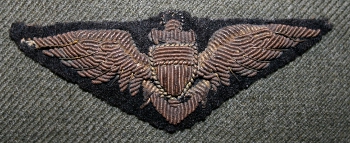
|
|
Width:
Height:
Hallmark:
Pin/Clutch:
Contributor:
Date Added:
Note:
|
Dennis Jackson Collection
5/2/2011
Worn by Ensign Benjamine Greely, Northern Bombing Group
|
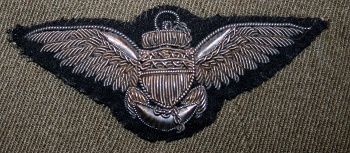
|
|
Width:
Height:
Hallmark:
Pin/Clutch:
Contributor:
Date Added:
Note:
|
Dennis Jackson Collection
5/2/2011
Worn by Ensign. Stanley Curran, USN Naval Aviator No.287 - NAS killingholme - H-16 Flying Boat Pilot
|
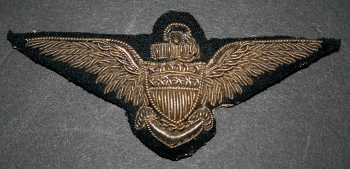
|
|
Width:
Height:
Hallmark:
Pin/Clutch:
Contributor:
Date Added:
Note:
|
Dennis Jackson Collection
5/3/2011
Worn by Ensign George Ludlow - Navy Cross - Silver & Bronze Italian Medal of Valor - Involved in the Navy Aviation's only Medal of Honor Action Adriatic Sea near Polo - Austrian Air Base
|
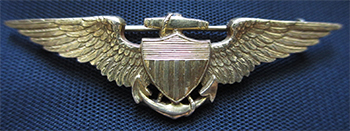
|
|
Width:
Height:
Hallmark:
Pin/Clutch:
Contributor:
Date Added:
Note:
|
2"
Alfred N Mundhall, 8-29-18, Tiffany & Co Makers, 18k Gold
Pin
John Ferguson Collection
09/18/2024
This is the mess dress size wing
|
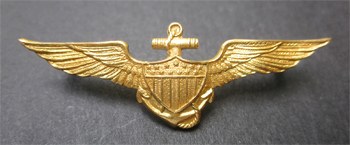
|
|
Width:
Height:
Hallmark:
Pin/Clutch:
Contributor:
Date Added:
Note:
|
1 1/2"
Myr Gold
Pin Back
Cliff Presley Collection
7/1/2013
Cap badge that was made by N. S. Meyer in 1918 and is marked on the back MYRGOLD. I got it back in 1981 directly from Francis O. Clarkson, Naval Aviator 474 (1895 -1985). He was also a North Carolina Superior Court judge, 1954-1968.
|
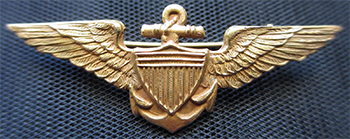
|
|
Width:
Height:
Hallmark:
Pin/Clutch:
Contributor:
Date Added:
Note:
|
1 1/2"
14K, Kirchenbauer hallmark
Pin
John Ferguson Collection
2/12/2021
This is a very rare maker
|
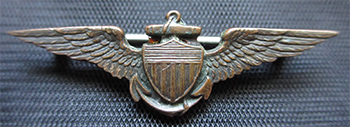
|
|
Width:
Height:
Hallmark:
Pin/Clutch:
Contributor:
Date Added:
|
1 1/2"
Tiffany & Co, Bronze
Pin
John Ferguson Collection
08/16/2022
|
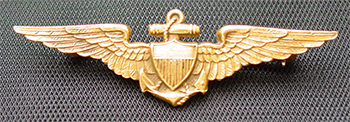
|
|
Width:
Height:
Hallmark:
Pin/Clutch:
Contributor:
Date Added:
|
1 1/2"
BB&B, 14K
Pin
John Ferguson Collection
09/15/2024
|

|
|
Width:
Height:
Hallmark:
Pin/Clutch:
Contributor:
Date Added:
|
1 1/2"
BB&B, Bronze
Pin
John Ferguson Collection
09/15/2024
|
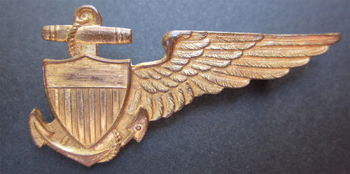
|
|
Width:
Height:
Hallmark:
Pin/Clutch:
Contributor:
Date Added:
Note:
|
Pin Back
Cliff Presley Collection
9/14/2010
Most collectors will argue that it is a Balloon Pilot badge... but it isn't. In August 1919 the Navy Department approved a change to the double wing naval aviation badge as follows:
The present gold pin with double wings based on the shield and anchor
will be worn only on wash summer uniforms. The winter uniforms will
carry a similar device of gold embroidery. Provision has been made by
the new regulation which designates student naval aviators and flying
mechanicians.
The student wears a pin similar to that of the graduate aviator, with the
exception that one wing is removed leaving a device similar to that worn
by observers abroad.
Regular members of seaplane flight crews among the enlisted
men will wear a pin similar to that of the student naval aviator, except
it shall be of silver. This change is made with the belief that there
should be a distinctive insignia for the graduate and student naval
aviators, and further, that the flying mechanician should also be
entitled to wear some mark of distinction.
The information above is documented in the 30 August 1919 issue of the
ARMY AND NAVY REGISTER, page 287.
Note that in 1922 this badge did become the Navy Balloon Pilot badge and continued that way through WW2. More examples of this style badge can be found in the US Navy/Marines - Balloon Pilot section from WW2.
|
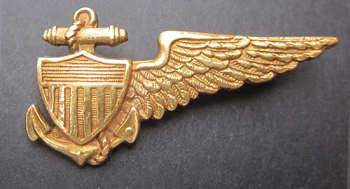
|
|
Width:
Height:
Hallmark:
Pin/Clutch:
Contributor:
Date Added:
|
B,B & B
Pin Back
Cliff Presley Collection
4/27/2013
|
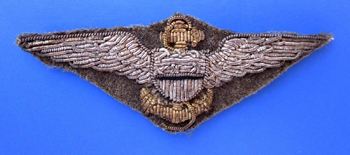
|
|
Width:
Height:
Hallmark:
Pin/Clutch:
Contributor:
Date Added:
Note:
|
3 1/4"
Cliff Presley Collection
4/8/2011
Worn by Rolland E. Corbin, Naval Aviator 621 (Lighter-Than-Air). Note the unusual two tone treatment of this full size embroidered badge with the wings made of silver bullion and the anchor made in gold bullion.
|
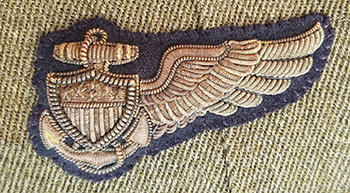
|
|
Width:
Height:
Hallmark:
Pin/Clutch:
Contributor:
Date Added:
Note:
|
Image shared by Cliff Presley
12/24/2019
U. S. Navy Seaplane Observer half-wing made of embroidered wire. This is an unofficial wing
worn by enlisted men who trained overseas in France to be aerial observers/gunners/bombers for
seaplane patrol. These men were part of the U. S. Navy's First Aeronautic Detachment No. 1
which consisted of two units. The first echelon arrived in France on June 5, 1917 and the second
on June 8, 1917, thus it became the first official American military air unit to set foot on French
soil after the United States declared war against Germany on April 4, 1917. After their training was
completed they received the rating Quartermaster (Aviation).
|